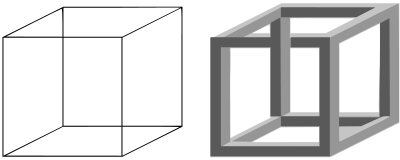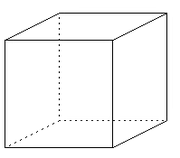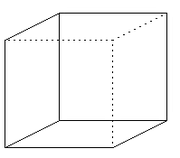
Necker cube
Encyclopedia

Optical illusion
An optical illusion is characterized by visually perceived images that differ from objective reality. The information gathered by the eye is processed in the brain to give a perception that does not tally with a physical measurement of the stimulus source...
first published as a rhomboid in 1832 by Swiss
Switzerland
Switzerland name of one of the Swiss cantons. ; ; ; or ), in its full name the Swiss Confederation , is a federal republic consisting of 26 cantons, with Bern as the seat of the federal authorities. The country is situated in Western Europe,Or Central Europe depending on the definition....
crystallographer
Crystallography
Crystallography is the experimental science of the arrangement of atoms in solids. The word "crystallography" derives from the Greek words crystallon = cold drop / frozen drop, with its meaning extending to all solids with some degree of transparency, and grapho = write.Before the development of...
Louis Albert Necker
Louis Albert Necker
Louis Albert Necker was a Swiss crystallographer and geographer. He is best remembered for devising the optical illusion now known as the Necker cube. He was a keen mountaineer and spent the latter half of his life in Scotland, and was buried in Portree.-References:...
.
Ambiguity
The Necker Cube is an ambiguous line drawing.


Humans do not usually see an inconsistent interpretation of the cube. A cube whose edges cross in an inconsistent way is an example of an impossible object
Impossible object
An impossible object is a type of optical illusion consisting of a two-dimensional figure which is instantly and subconsciously interpreted by the visual system as representing a projection of a three-dimensional object although it is not actually possible for such an object to exist An impossible...
, specifically an impossible cube (compare Penrose triangle
Penrose triangle
The Penrose triangle, also known as the Penrose tribar, is an impossible object. It was first created by the Swedish artist Oscar Reutersvärd in 1934. The mathematician Roger Penrose independently devised and popularised it in the 1950s, describing it as "impossibility in its purest form". It is...
).
With the cube on the left, most people see the lower-left face as being in front most of the time. This is possibly because people view objects from above, with the top side visible, far more often than from below, with the bottom visible, so the brain "prefers" the interpretation that the cube is viewed from above. Another reason behind this may be due to the brain's natural preference of viewing things from left to right, therefore seeing the leftmost square as being in front.
There is evidence that by focusing on different parts of the figure one can force a more stable perception of the cube. The intersection of the two faces that are parallel to the observer forms a rectangle, and the lines that converge on the square form a "y-junction" at the two diagonally opposite sides. If an observer focuses on the upper "y-junction" the lower left face will appear to be in front. The upper right face will appear to be in front if the eyes focus on the lower junction (Einhauser, et al., 2004).
 |
It is possible to cause the switch to occur by focusing on different parts of the cube. If one sees the first interpretation on the right it is possible to cause a switch to the second by focusing on the base of the cube until the switch occurs to the second interpretation. Similarly, if one is viewing the second interpretation, focusing on the left side of the cube may cause a switch to the first. |
The Necker Cube has shed light on the human visual system. The phenomenon has served as evidence of the human brain
Human brain
The human brain has the same general structure as the brains of other mammals, but is over three times larger than the brain of a typical mammal with an equivalent body size. Estimates for the number of neurons in the human brain range from 80 to 120 billion...
being a neural network
Neural network
The term neural network was traditionally used to refer to a network or circuit of biological neurons. The modern usage of the term often refers to artificial neural networks, which are composed of artificial neurons or nodes...
with two distinct equally possible interchangeable stable states. Sidney Bradford
Sidney Bradford
Sidney Bradford went blind at 10 months of age but regained sight on both eyes after a cornea transplant at the age of 52. He was the subject of many scientific studies of perception by neuropsychologist Richard Gregory....
, blind
Blindness
Blindness is the condition of lacking visual perception due to physiological or neurological factors.Various scales have been developed to describe the extent of vision loss and define blindness...
from the age of ten months but regaining his sight following an operation at age 52, did not perceive the ambiguity that normal-sighted observers do.
Epistemology
The Necker Cube is used in epistemology (the study of knowledge) and provides a counter-attack against naïve realismNaïve realism
Naïve realism, also known as direct realism or common sense realism, is a philosophy of mind rooted in a common sense theory of perception that claims that the senses provide us with direct awareness of the external world...
. Naïve realism (also known as direct or common-sense realism) states that the way we perceive the world is the way the world actually is. The Necker Cube seems to disprove this claim because we see one or the other of two cubes, but really, there is no cube there at all: only a two-dimensional drawing of twelve lines. We see something which is not really there, thus (allegedly) disproving naïve realism. This criticism of naïve realism supports representative realism.
A rotating Necker Cube was used to demonstrate that the human visual system can recruit new visual cues
Cue recruitment
Cue recruitment is a form of associative learning in human perception. A cue in perception is a signal that can be measured by an observer's perceptual system, that is informative about the state of some property of the world. A trusted cue is one that the system utilizes to construct appearance,...
that affect the way things look.
Impossible cube

Impossible object
An impossible object is a type of optical illusion consisting of a two-dimensional figure which is instantly and subconsciously interpreted by the visual system as representing a projection of a three-dimensional object although it is not actually possible for such an object to exist An impossible...
that draws upon the ambiguity present in a Necker Cube illustration. An impossible cube is usually rendered as a Necker Cube in which the edges are apparently solid beams. This apparent solidity gives the impossible cube greater visual ambiguity than the Necker Cube, which is less likely to be perceived as an impossible object. The illusion plays on the human eye's interpretation of two-dimensional pictures as three-dimensional objects.
In M. C. Escher
M. C. Escher
Maurits Cornelis Escher , usually referred to as M. C. Escher , was a Dutch graphic artist. He is known for his often mathematically inspired woodcuts, lithographs, and mezzotints...
's lithograph Belvedere
Belvedere (M. C. Escher)
Belvedere is a lithograph print by the Dutch artist M. C. Escher, first printed in May 1958. It shows a plausible-looking building which turns out to be impossible....
, the figure of a boy seated at the foot of the building is holding a type of impossible cube; the rest of the scene is based on the same principle that makes the impossible cube. In the scene, a ladder from the inside of the first story leads to the outside of the second. However, this is not appreciated by the prisoner in the basement cell because the basement is a possible cuboid
Cuboid
In geometry, a cuboid is a solid figure bounded by six faces, forming a convex polyhedron. There are two competing definitions of a cuboid in mathematical literature...
and he is unambiguously on the inside.
A doctored photograph purporting to be of an impossible cube was published in the June 1966 issue of Scientific American
Scientific American
Scientific American is a popular science magazine. It is notable for its long history of presenting science monthly to an educated but not necessarily scientific public, through its careful attention to the clarity of its text as well as the quality of its specially commissioned color graphics...
, where it was called a "Freemish Crate".

